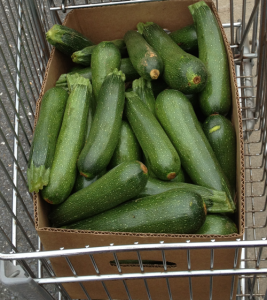
What do to with a full box of squash?
I was one of the millions of people on the East Coast who lost power during the derecho on June 29th. Thanks to some dear friends who had both power and an extra chest freezer, I managed to keep my frozen meats and fruits safe (including the peas I picked in the spring). But I did lose most of the vegetables from last summer which I still had. So I’ve been on a tear to replace those.
Buying vegetables in the summer at the height of their availability means the vegetables are at the height of their flavor and nutritional value. By preserving those vegetables at that time, I not only lock in those attributes, but I save money. It does mean that I go to my orchard store not knowing what I can get for the week. This week I scored a box of summer squash (about 25 pounds) for $10.
Summer squash is one of those vegetables that is both prolific and good for you. There are jokes of people leaving bags of summer squash in unlocked cars in the summer just to get rid of it. Summer squash varieties include zucchini, yellow crookneck, and patty pans. The flavor and the texture, along with the nutrition are pretty much interchangeable. The box of summer squash I got was all zucchini which was just fine with me. I wanted a long, slender squash to work with this time. I have in the past, worked with boxes of squash that incorporated both the long, slender squashes as well as the pattypans. The taste is the same, but in some cases (as you shall see, I really want the long, thin squashes).
Nutritionally, summer squash is a very low carbohydrate vegetable. A cup of squash had 3 net grams of carbohydrates, 18 calories. It has a large amount of vitamin C which promotes tissue repair and acts as an antioxidant.
I eat a lot of fresh summer squash during this time of year. Its cheap and easy. I tend to brush it with some olive oil and grill it then create a balsamic vinegar and olive oil dressing. I’ve also wrapped grilled zucchini around goat cheese. Summer Squash pancakes (grated with onions and some coconut flour) are also a good way to eat it. And that’s just fine to do with the squash I get from my CSA Share. However, I buy a box of summer squash to preserve it for winter.
Zucchini ribbons are a good low carb substitute for pasta. So with my vegetable peeler, I reduce a number of the zucchini to ribbons which I blanch and freeze.

Squash Ribbons – Great Pasta Substitute!
I also shred zucchini for freezing. I use the shredded squash in saute’s and stir frys. All together, I did about 12 bags of both shredded and ribboned squash. When I freeze the squash this way, I place it in the bags and vacuum seal them. I then drop the bags into boiling water for about 3-4 minutes and then plunge into an ice bath. This blanches the squash, so it will last longer by killing bacteria that will eventually spoil the food. It helps frozen foods to last longer (and keeps the color better).
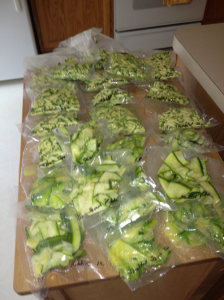
Squash in bags, ready for blanching
This year, I’m also cutting squash into half-inch rounds which I freeze separately on cookie sheets, then pop into a freezer bag. I’ll use those in the winter by rolling them in almond meal or ground up pork rinds and then frying them. I’ve never done that before, but my understanding is that so long as I don’t defrost them and cook them while they are frozen, they work very well.
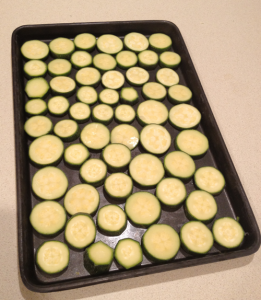
Freezing squash rounds
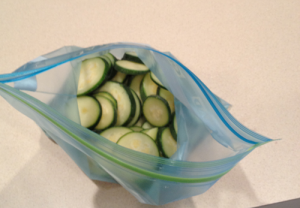
Frozen Squash rounds in Freezer Bag
I also dehydrate the squash. This year, I’m doing it two ways. One is simply chopping the squash up and dehydrating the pieces. I’ll use these dried pieces to go into soups and stews. I’m also cutting them into thin strips and drying them. I want to use those for lasagna pasta in the winter. I’m curious how that will work, but I think it should work rather well.
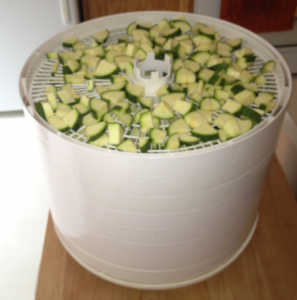
Dehydrating squash for soups and stews
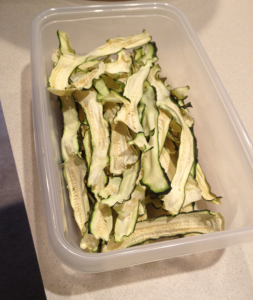
Dehydrated Squash Slices
I tried canning the squash last year as pickles, but didn’t really enjoy them, so I’m not doing that this year. After a few years of trying to can summer squash as pickles and relishes, they just aren’t appealing to me. So I’m not canning them any more.
On a low carbohydrate (ketogenic diet), summer squash is a great addition to my ingredient list and the 24 pounds of zucchini is going to go a long way towards filling up my freezer.
Related articles






